Canker Update: Where is Canker now?
Jamie Yates
Citrus canker has been a serious problem since the last Florida outbreak began in 1995. Numerous residents lost their only tree while commercial growers continue to burn trees on a daily basis due to canker. If you have spoken to any citrus grower or caretaker in the last few months, you will realize that canker is still a threat and we are learning to live with it every day.
It is vital that the citrus industry and Florida residents work together to prevent further spread of citrus canker. It is not a job that can be done by one person or one company but everyone coming together. We must learn about citrus canker and apply basic preventative measures to protect the $9 billion dollar Florida citrus industry.
-
History
- Canker was first introduced in Florida around 1912 from imported seedlings from Japan and declared eradicated in 1933
- Second discovery in Florida in Manatee county (1986) and thought to be eradicated in 1994
- Third introduction in Florida in urban Miami in 1995
- Canker spread from Miami in 1995 to twenty-five counties throughout central and south Florida today
- A statewide mandatory eradication with the 1,900 foot (579m) rule was implemented in 2000 after determining the original 125 foot (38.1m) rule was not effective
- Quarantine areas were established when citrus canker was detected
- Within a quarantine area, decontamination was required upon entering and exiting
- Mandatory statewide decontamination procedures became required in April 2000
- By March 2002, over 1.56 million commercial trees and almost 600,000 infected and exposed dooryard trees were removed or cut back
- Tree removal of infected and exposed trees was delayed due to law suits in 2002 by homeowners in Broward county
- The hurricanes of 2004-2005 increased the spread of canker
- In 2003, sixteen counties had a history of canker, but by 2005 twenty-four counties were infected with canker
- The first nursery with canker was found in May 2005
- The mandatory eradication ended January 11, 2006
- Currently, the removal of infected trees is voluntary
- Decontamination procedures are still in effect statewide to prevent the spread of canker
- The state of Florida is under quarantine and the movement of citrus fruit is prohibited to any citrus producing region
References
- Citrus Canker: The Pathogen and Its Impact Click Here
-
Decontamination
- Upon exiting a citrus grove you must decontaminate all equipment and all personnel
- Growers are required to train their employees each year on the proper decontamination methods
- Trainings are available through University of Florida, IFAS personnel (contact your local county extension agent)
- Grower must provide adequate quantities of approved decontaminant solutions that are premixed and maintained at appropriate dilutions
- Approved Decontamination Products and Methods are listed at:
- Why should I decontaminate?
- To slow canker spread around the state to unaffected areas
- Citrus canker is a highly contagious plant disease
- No groves equals no jobs
- It’s the law!
- Will the decontaminant solution harm humans?
- Decontaminant solutions are like a mild antibacterial soap for personnel
- Two types of solution are used: personnel and equipment
- Equipment solutions are quaternary ammonia and should not contact skin or fruit
- Do not drink any decontaminant solution
- Field Identification of Citrus Canker Symptoms and Decontamination Procedures PDF
-
Symptoms & Susceptibility
- Symptoms appear on fruit, leaves and twigs
- Causes necrotic lesions
Leaf Symptoms
- Small, round (often raised) blister-like lesions with water-soaked margins and yellow
halos; lesions often appear on both sides of leaf surface - Heavy or severe infection causes defoliation
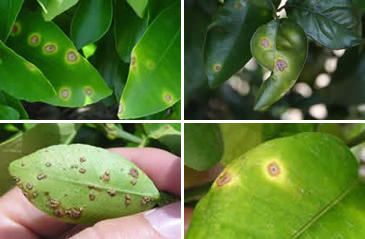
Leaf Symptoms
- Raised lesions on fruit (oranges & grapefruit) create a water-soaked margin with
yellow halo - Fruit drop

Twig Symptoms
- Twig lesions are similar in appearance to fruit lesions; lesions on stems cause recurring infection

Susceptibility
- Highly susceptible
- Grapefruit, Navel oranges, Some early oranges (example: Early Gold) - Less susceptible
- Hamlins, Tangelos - More Toleran
- Tangerines, Hybrids (example: Murcott), Valencia
-
Spread
- Citrus canker is highly contagious
- Citrus canker is NOT harmful to humans or animals
- Can be spread by natural means (uncontrollable) and by humans (controllable)
- Natural spread by wind-driven rain, overhead irrigation, flooding, incidental spread by insects and birds, animals
- Human spread responsible for moving canker over long distances around state (examples: Miami to Cape Coral (Lee County), Miami to Golden Gate (Collier County), Miami to Orlando (Orange County)
- Human transport of infected/exposed plant material is primary means of spreading the canker pathogen over long distance
-
Links
Links
UF/IFAS Publications
*All documents are in PDF format
- Citrus Leafminer
- Parasitoid of the Citrus Leafminer, Semielacher petiolatus (Girault) (Insecta: Hymenoptera:Eulophidae)
- Florida Citrus Pest Management Guide: Citrus Canker
Citrus Canker Articles and Websites
- Approved Decontamination Products and Methods (complete list of decontamination products and contact information)
- Citrus Canker: The Pathogen and It's Impact (history and biology of citrus canker)
- Integrated Plant Genetics - Citrus Canker In-Depth (detailed information about citrus canker)
-
Eradication
- We are currently no longer under a mandatory eradication program. The eradication initially began in 2000 to stop the spread of canker and to protect the Florida citrus industry. Due to the wide spread infection of canker, the mandatory eradication program ended on January 11, 2006.
- Homeowners and growers who lost trees under the eradication program may replant citrus trees that come from a certified nursery in the state of Florida.

Impact of Eradication
- An excess of five million nursery trees were destroyed
- An excess of eleven million residential and commercial citrus trees were destroyed
- 100% of the Division of Plant Industry Dundee Budwood Foundation was lost due to eradication

-
Pathogen
- Plant diseases can be caused by fungi, viruses, insects, and bacteria. Abiotic (non-living) stresses, such as nutrient deficiency, chemical spray damage, and wind damage can also cause unhealthy plants.
- Citrus Canker is caused by Xanthomonas citricitri
- Gram negative bacterium (Gm-) - Small (cannot be seen by the naked eye)
- Size and shape: 1 by 3 microns, rod, covered with slime, single polar flagellum

- Reproduction: divide every 20-30 minutes at optium temperatures (28°-30°C/82.4°-86°F) . In 6 to 8 hours, population can reach 1 million cells
- Have a flagellum (tail-like structure used for movement)
- Survive in moist conditions, when they dry, they die
- Must have a host to survive in the natural environment
- Florida Pest Management Guide: Citrus Canker
- Canker Life Cycle

-
Diseases Commonly Mistaken for Citrus Canker

Citrus Scab
- Caused by the fungus Elsinoe fawcettii
- Found on fruit, leaves and twigs
- Deforms leaves
- Wart like symptoms
- Light tan in color
- Affects grapefruit, Temples, Murcotts, tangelos, and some other tangerine hybrids
Additional Information - Florida Citrus Pest Management Guide: Citrus Scab PDF
- A Guide to Citrus Disease Identification PDF
- Your Florida Dooryard Citrus Guide - Common Pests, Diseases, and Disorders of Dooryard Citrus PDF
- Citrus Scab PDF
- Quick Reference Guide to Foliar Fungicides PDF
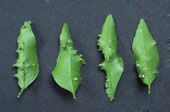
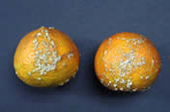
Citrus Melanose
- Caused by the fungus Diaporthe citri
- Found on fruit and leaves
- Feels like sandpaper
- Red-brown in color
- Grapefruit is very susceptible but all citrus may be affected
Additional Information - Florida Citrus Pest Management Guide: Melanose PDF
- A Guide to Citrus Disease Identification PDF
- Your Florida Dooryard Citrus Guide - Common Pests, Diseases, and Disorders of Dooryard Citrus PDF
- Melanose
- Quick Reference Guide to Foliar Fungicides
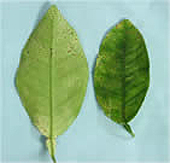

Alternaria Brown Spot
- Caused by the fungus Alternaria alternata
- Found on young fruit, leaves and twigs
- Brown to black spots surrounded by a yellow halo
- Affects Dancy tangerines, Minneola tangelos, Murcotts, Orlando tangelo, Nova tangelo, Lee tangelo and Sunburst tangerine
- Does not affect oranges; may affect grapefruit if located next to highly infected tangelos or tangerines
Additional Information - Florida Citrus Pest Management Guide: Alternaria Brown Spot PDF
- Alternaria Brown Spot PDF
- Quick Reference Guide to Foliar Fungicides PDF


Citrus Bacterial Spot (CBS)
- Caused by bacterium Xanthomonas axonopodis pv. citrumelo
- Occurs in nursersies
- Does not survive in commercial groves

Anthracnose
- Caused by the fungus Colletotrichum gloeosporioides
- Primarily affects fruit
- Tangerines are especially susceptible
- Occurs primarily as a postharvest disease
Additional Information - Anthracnose PDF
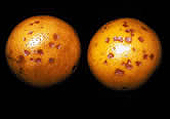
Greasy Spot
- Caused by the fungus Mycosphaerella citri
- Looks like drops of oil
- Can be found on fruit or leaves
- Most severe on grapefruit leaves, Pineapple oranges, Hamlins and tangelos
Additional Information - Florida Pest Management Guide: Greasy Spot PDF
- Greasy Spot PDF
- A Guide to Citrus Disease Identification PDF
- Your Florida Dooryard Citrus Guide - Common Pests, Diseases, and Disorders of Dooryard Citrus PDF
- Quick Reference Guide to Foliar Fungicides PDF


-
Photo Gallery
...
-
Management
Decontamination
- Decontamination has been found to be effective for preventing the spread of citrus canker by human activity
- Decontamination solutions kill the bacteria; therefore, reduce the spread of the bacteria
- Decontamination is required by law upon exiting a citrus grove, but most growers require personnel and equipment to be decontaminated upon entering and exiting
- It is required by the Citrus Health Response Program that employees have annual decontamination training
- Trainings are available upon request from the University of Florida-IFAS (contact your local county extension agent, see below)
Tree Removal
- Tree removal is voluntary and is no longer enforced by the state of Florida.
- In areas previously free of canker, the removal of infected citrus trees is recommended to slow disease establishment agent, see below)
Defoliation and Pruning
- Defoliants can reduce the inoculum levels in severely affected groves, but there are no approved defoliants for citrus. High rates of legal copper fungicides or fertilizers can be used.
- Pruning is generally ineffective to control canker and should only be done under dry conditions in a selective manner.
- Pruning can cause wounds that allow the bacterium to enter the tree
Windbreaks
- Windbreaks have been proven to slow wind to below 18 mph (8 m/s) and to be highly effective in reducing the spread and severity of citrus canker.
- They are more effective than copper alone as was demonstrated by Gottwald and Timmer (1995).
- For more information on the selection of windbreaks, please visit Living and Artificial Windbreaks for Citrus

Copper Sprays
- Copper is the only registered product for the prevention of citrus canker.
- Use rates indicated on the label
Leafminer control
- Leafminer galleries create wounds that allow the bacterium to enter the leaf and cause many times more infections than without leafminer.
Florida Citrus Pest Management Guide: Citrus Canker PDF
Florida Citrus Pest Management Guide: Asian Citrus Psyllid and Citrus Leafminer PDF
-
Contacts
Megan Dewdney, Ph.D.
Plant Pathologist Extension Specialist
863-956-8651
mmdewdney@ufl.eduLukasz Stelinski, Ph.D.
Entomology and Nematology
863-956-1151
stelinski@ufl.eduJamie Burrow
Extension Program Manager
863-956-8648
jdyates@ufl.eduChris Oswalt
Multi-County Citrus Extension Agent
Polk and Hillsborough Counties
863-519-8677
wcoswalt@ifas.ufl.eduSteve Futch, Ph.D.
Multi-County Citrus Extension Agent
DeSoto, Hardee, Manatee and Sarasota Counties
863-956-1151
shf@ufl.eduMongi Zekri, Ph.D.
Multi-County Citrus Extension Agent
Hendry, Glades, Lee, Charlotte and Collier Counties
863-674-4092
maz@ifas.ufl.eduLaurie Hurner
Citrus Extension Agent
Highlands County
863-402-7150
lhurner@ufl.edu
